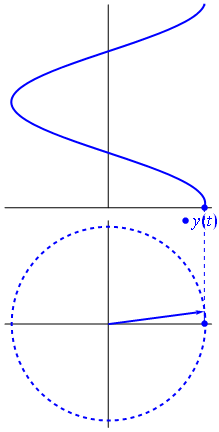Why use complex numbers to represent amplitude and phase of AC
Actually the motivation is quite simple.
When you have a linear circuit and you stimulate it with only one frequency, wherever you will look you will always find that very same frequency, only the amplitude and the phase of the wave you measure change.
What you do then is say well let's forget of frequency, if I keep track of amplitude and phase of voltages and/or currents around the circuit it will be more than enough. But how can you do that? Isn't there any mathematical tool that allows you to keep track of amplitude and phase? Yeah, you've got it: vectors. A vector has an amplitude, that is its length, and a phase, that is the angle it forms with the x axis, ccw direction is positive.
Now you can object ok vectors are cool, but isn't anything cooler? And why do we need to use the imaginary unit?
The answer to the second question is easy: making calculations with vectors is quite a pain, a notation pain:
$$ \pmatrix{2\\3}+\pmatrix{1\\7}=\pmatrix{3\\10} $$
And that's addition alone! Well that's only a notation problem, if we choose another base of \$\mathbb{R}^2\$ things may be better... And this base happens to exist, but requires the imaginary unit \$j\$. The previous mess becomes: $$ 2+3j+1+7j=3+10j $$ Much easier, isn't it?
Ok but what has an imaginary vector in common with a voltage? Well try to imagine the Gauss plane, the x axis is the real axis, the y axis is the imaginary one.
A voltage can be represented by a vector centered on the origin, its length being equal to the voltage value, its starting angle being equal to the phase. Now the magic trick: start rotating the vector so that its angular speed \$\omega\$ corresponds to the desired frequency:

Bam. That's what we call a phasor, and that little guy is the strongest weapon you have against tough circuits.
So why are these phasors special? That's because if you take two real voltages: $$ v_1(t)=V_1\cos(2\pi f_0t+\theta_1)\\ v_2(t)=V_2\cos(2\pi f_0t+\theta_2) $$ and you want to sum them, it happens that if you sum the corresponding phasors and then get back in the real domain the result is the same. This is not magic of course, it depends on the mathematics affinity between cosinusoids and the complex exponential. Just believe me, or believe this cool picture:

And the best thing is that all the real circuit analysis you've studied up to now keeps working with phasors and complex impedances. That is: Ohm's law holds with phasors and complex impedances, and that's great since we have a ton of tools to solve circuits that are built on Ohm's and Kirchhoff's laws, and we can still use them.
With phasors taking the derivative/integrating is also super easy: as you know, since we're speaking of sines and cosines all at the same frequency it's only a matter of phase shift, and that -surprise- is very clear if you use the complex exponential representation.
TL;DR: Sinusoids are represented as rotating vectors on the polar plane, it's pretty much like stopping time while they rotate and take a photo, i.e. calculate phase and amplitude relationships. Just check out the phasor page on wikipedia. And check this other more concise answer too.
Quote: "Is it purely from a mathematical point of view to make the analysis of circuits easier?"
I am not sure if this part of the question was answered already sufficiently. Therefore: Yes - using complex mathematics for describing sinusoidal signals has no direct physical relevance. It is just to "make analyses easier".
As an example: Introducing Euler`s famous formula for sinus signals into the Fourier series leads to negative frequencies (symmetrical to positive frequencies). Hence, the question arises: Do negative frequencies exist in reality? The answer is NO! It is just a helpful mathematical tool.
Say that we have a simple circuit with a voltage source \$v(t) = Vcos(\omega t + \phi)\$ connected in series with an inductive coil with inductance \$L\$. Then,
$$ v(t) = Re\{Ve^{j(\omega t + \phi)}\} = L\frac{di}{dt}\\ Re\{Ve^{j(\omega t + \phi)}\}\ dt = L\ di\\ \int Re\{Ve^{j(\omega t + \phi)}\}\ dt = L \int \ di\\ Re\{\int Ve^{j(\omega t + \phi)}\ dt\} = L i(t)\\ Re\{\frac{1}{j\omega}Ve^{j(\omega t + \phi)}\} = Li(t)\\ i(t) = Re\{\frac{1}{j\omega L}Ve^{j\phi}e^{j\omega t}\} $$
What does this buy us? Well we can simply treat the coil as a resistor with value \$j\omega L\$ Then we could replace \$v(t)\$ with the constant \$v_o = Ve^{j\phi}\$ . In this simplified circuit we use ohm's law to find \$i_o = \frac{v_o}{R} = \frac{v_o}{j\omega L}\$. Then in order to find the actual value of \$i(t)\$ we simply multiply \$i_o\$ with \$e^{j\omega t}\$ and take it's real part. This can be extended to all passive components. Therefore we can model all alternating quantities with complex numbers, simplifying all calculations in the process. We can then change them back to their non-complex form whenever we need to.